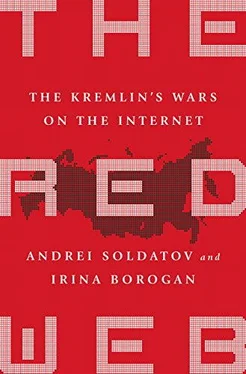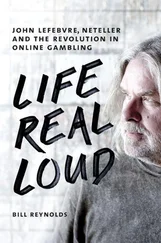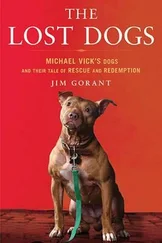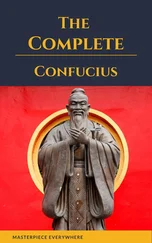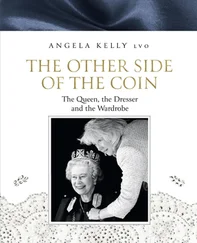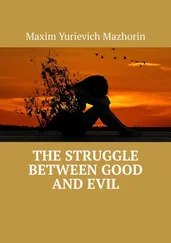Андрей Солдатов - The Red Web - The Struggle Between Russia's Digital Dictators and the New Online Revolutionaries
Здесь есть возможность читать онлайн «Андрей Солдатов - The Red Web - The Struggle Between Russia's Digital Dictators and the New Online Revolutionaries» весь текст электронной книги совершенно бесплатно (целиком полную версию без сокращений). В некоторых случаях можно слушать аудио, скачать через торрент в формате fb2 и присутствует краткое содержание. Город: New York, Год выпуска: 2017, ISBN: 2017, Издательство: PublicAffairs, Жанр: История, Политика, Интернет, Публицистика, на английском языке. Описание произведения, (предисловие) а так же отзывы посетителей доступны на портале библиотеки ЛибКат.
- Название:The Red Web: The Struggle Between Russia's Digital Dictators and the New Online Revolutionaries
- Автор:
- Издательство:PublicAffairs
- Жанр:
- Год:2017
- Город:New York
- ISBN:978-1-61039-57-3-1
- Рейтинг книги:3 / 5. Голосов: 1
-
Избранное:Добавить в избранное
- Отзывы:
-
Ваша оценка:
- 60
- 1
- 2
- 3
- 4
- 5
The Red Web: The Struggle Between Russia's Digital Dictators and the New Online Revolutionaries: краткое содержание, описание и аннотация
Предлагаем к чтению аннотацию, описание, краткое содержание или предисловие (зависит от того, что написал сам автор книги «The Red Web: The Struggle Between Russia's Digital Dictators and the New Online Revolutionaries»). Если вы не нашли необходимую информацию о книге — напишите в комментариях, мы постараемся отыскать её.
The Red Web: The Struggle Between Russia's Digital Dictators and the New Online Revolutionaries — читать онлайн бесплатно полную книгу (весь текст) целиком
Ниже представлен текст книги, разбитый по страницам. Система сохранения места последней прочитанной страницы, позволяет с удобством читать онлайн бесплатно книгу «The Red Web: The Struggle Between Russia's Digital Dictators and the New Online Revolutionaries», без необходимости каждый раз заново искать на чём Вы остановились. Поставьте закладку, и сможете в любой момент перейти на страницу, на которой закончили чтение.
Интервал:
Закладка:
The US government took the gatherings in Garmisch very seriously every year. High-level officials were sent; in 2010 the US delegation included Christopher Painter, the second-ranking White House official on cyber security, and Judith Strotz, the director of the State Department’s Office of Cyber Affairs. [9] John Markoff, “At Internet Conference, Signs of Agreement Appear Between U.S. and Russia,” New York Times , April 15, 2010, www.nytimes.com/2010/04/16/science/16cyber.html?_r=0 .
Russian officials in charge of information security often spoke bitterly of US domination of the Internet, believing all the tools and mechanisms for technical control were in US hands. Their main target was the Internet Corporation for Assigned Names and Numbers, known as ICANN, a nonprofit organization headquartered in California. In 1997 President Clinton directed the secretary of commerce to privatize the management of the domain name system, a critical part of the Internet that serves as a giant warehouse of web addresses looked up every time a user wants to go somewhere online. The Defense Advanced Research Projects Agency, the National Science Foundation, and other US research agencies had previously performed this task. On September 18, 1998, ICANN was created and given a contract with the US Department of Commerce to oversee a number of Internet-related tasks, but the most important among them was to manage the distribution of domain names worldwide. In the 2000s other nations campaigned to have a greater role in ICANN, but the Kremlin’s idea was more radical: to strip ICANN of its powers.
The president of ICANN, Paul Twomey, hastened to the second gathering in Garmisch in 2008. He and other high-ranking ICANN representatives tried to keep open channels of communications with the Russians. One of the top US ICANN representatives who made sure always to attend was George Sadowsky. Looking always professorial, he taught mathematics at Harvard and was a technical adviser to the United Nations in the 1970s. In 2001 Sadowsky became executive director of the Global Internet Policy Initiative, which promoted Internet freedoms in the former Soviet Union and Central Asia. In 2009 he was selected to the board of directors of ICANN. Sadowsky had a great deal of experience in dealing with Russian officials. He found the endless discussions to be frustrating, as both sides saw the world differently and had trouble even agreeing to a common language about the Internet; there were very basic divisions over definitions regarding the Internet. “Is it a communications service or is it an information service?” he recalled. “And this went on, and on, and on.” [10] George Sadowsky, interview with authors, January 2015.
In Garmisch both Russians and Americans tried to be pleasant and friendly, but they were at a stalemate. And with each passing year the discussions became increasingly difficult—after the conference in 2010 Sadowsky admitted, “The Russians have a dramatically different definition of information security than we do; it’s a broader notion, and they really mean state security.” [11] Markoff, “At Internet Conference.”
When the Russian officials failed to get an agreement with the United States about ICANN, they shifted strategy, looking for a new way to assert more sovereignty over the Internet. This new approach led them to the International Telecommunications Union, or ITU. With headquarters in Geneva, the organization was originally established in 1895 to regulate the telephone and telegraph. It is a specialized UN agency, and as such, it is dependent on the member states.
The ITU was not involved in Internet governance until late 2006, when Hamadoun I. Touré was elected its secretary general. Touré made the Internet a central issue for the ITU from the start of his tenure. A citizen of Mali, he speaks fluent Russian and studied at the Communications Institute in Leningrad, the same institute where Boris Goldstein, one of the main Russian experts on SORM, studied and has been working for decades. Touré was well known in and maintained close ties with Russia—he was first elected and then, in 2010, reelected with the full support of Russia. As secretary general of ITU, he became very critical of ICANN, and in August 2010 he even refused Rod Beckstrom, then chief executive and president of ICANN, permission to attend an ITU conference.
Krutskikh spotted all this jockeying and, frustrated by the failures to change ICANN, moved to promote a larger role for the ITU. This was a surprising development for Sadowsky. When he met Krutskikh at a Moscow conference in 2008, the Russian official was pleasant and restrained. But it was another story two years later when they met again at the same conference. Sadowsky said something unfavorable about the ITU, and Krutskikh responded emotionally and forcefully, interrupting the American midremarks.
For Sadowsky, it seemed like Krutskikh—and Russia—had wagered a big bet on the ITU.
The tumultuous uprisings of the Arab Spring that threw out long-serving authoritarian leaders—uprisings that Internet communications accelerated—suddenly made the issue of Internet governance more urgent for Putin. In June 2011 Putin went to Geneva to talk to Touré. They met at the large hall at the UN Office, and Putin reminded Touré that Russia cofounded the ITU and went on to say that Russia intended to actively participate in “establishing international control over the internet” by using the capabilities of the ITU. [12] “Prime Minister Vladimir Putin Reaffirms the Russian Federation’s Support for ITU,” ITU News , November 5, 2011, https://itunews.itu.int/En/1444-Prime-Minister-Vladimir-Putin-reaffirms-the-Russian-Federation%C2%92s-support-for-ITU.note.aspx ; Jerry Brito, “The Case Against Letting the UN Govern the Internet,” Time , February 13, 2012, http://techland.time.com/2012/02/13/the-case-against-letting-the-united-nations-govern-the-internet ; and Leo Kelion, “US Resists Control of Internet Passing to UN Agency,” BBC, August 3, 2012, www.bbc.com/news/technology-19106420 .
It was an audacious idea: to control the Internet using a century-old UN agency.
Krutskikh, in preparation for the new effort, moved in August 2011 to another department inside the foreign ministry. The department was closely tied to the security services and had once been supervised by a former first deputy director of the FSB. Then in March of the following year he was made a special coordinator for issues regarding political use of information and telecommunication technologies—the Internet—and given a rank of ambassador. He was to be Putin’s point man on a campaign to wrest more control of the Internet from the United States.
The next major ITU conference was scheduled for December 2012 in Dubai. The top ITU officials intended to use the gathering to change the rules for the Internet globally through a review of an existing global treaty, which was last updated in 1988, before the digital era. The ITU intended to amend the treaty to include the Internet and, thus, make it subject to ITU regulation. And the Kremlin decided to make the conference in Dubai the launch pad for a general offensive against US domination of the Internet.
Krutskikh went to work recruiting other countries to support Russia. He won nods of agreement from China, where the Internet is rigidly and widely censored, and from Central Asian nations that were former Soviet republics and also largely authoritarian. In May 2012 Krutskikh won backing directly from the Kremlin. The former minister of communications Igor Shchegolev moved to the administration as Putin’s adviser on the Internet, and he fully shared Krutskikh’s ideas about the ITU and ICANN. Shchegolev had accompanied Putin in June 2011 to Geneva and took part in the meeting with Touré. [13] “Prime Minister Vladimir Putin Reaffirms the Russian Federation’s Support for ITU.”
The new communications minister, Nikolai Nikiforov, twenty-nine, was technically savvy but inexperienced. He was appointed to his position from Kazan, Tatarstan, where he had served as Tatarstan’s minister of communications. He was far from being an independent political figure.
Интервал:
Закладка:
Похожие книги на «The Red Web: The Struggle Between Russia's Digital Dictators and the New Online Revolutionaries»
Представляем Вашему вниманию похожие книги на «The Red Web: The Struggle Between Russia's Digital Dictators and the New Online Revolutionaries» списком для выбора. Мы отобрали схожую по названию и смыслу литературу в надежде предоставить читателям больше вариантов отыскать новые, интересные, ещё непрочитанные произведения.
Обсуждение, отзывы о книге «The Red Web: The Struggle Between Russia's Digital Dictators and the New Online Revolutionaries» и просто собственные мнения читателей. Оставьте ваши комментарии, напишите, что Вы думаете о произведении, его смысле или главных героях. Укажите что конкретно понравилось, а что нет, и почему Вы так считаете.
